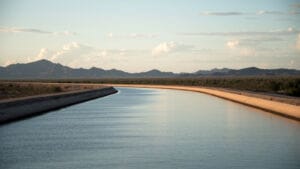In case anyone missed it, the five-month 2014 winter runoff season finished quite a bit like the previous three January-through-May periods: DRY.
In fact, this year’s five-month snowmelt season produced only 148,000 acre-feet _ the eighth-driest since Salt River Project has been keeping records for the last 116 years and the fourth consecutive year with below-median winter inflows into the SRP reservoirs.
The good news, however, is that the long-term forecast suggests the possibility of an El Niño event by the fall and winter of water year 2015. El Niño is characterized by warmer-than-normal ocean temperatures in the equatorial eastern Pacific. During El Niño events, the Pacific jet stream tracks farther south, with storms from the Pacific Ocean taking aim at the southwestern U.S. while, at the same time, the subtropical jet stream is displaced to the north, often leading to above-normal precipitation over Arizona.
Charlie Ester, SRP’s manager of Water Resource Operations, said that bodes well for a more active monsoon season followed by wetter conditions on the Salt and Verde watersheds next winter.
Ester said an “average” January-to-May runoff season would go a long way toward refilling the reservoirs on the Salt and Verde rivers that today stand at a healthy 53 perfect full with 1.22 million acre-feet stored – nearly the same percentage as one year ago. That followed the most productive runoff season — 444,788 acre-feet of stream flow accumulated in the first five months of 2013 – since 1,418,960 acre-feet of water was accumulated during the 2010 runoff season. The 30-year median runoff is 534,336 acre-feet.
“In spite of the consecutive dry winters, our reservoir system is in a good position to provide full allocation to our water customers because of SRP water resource management practices,” said Ester. “We’re keeping our fingers crossed for an active 2015 runoff season, and so far the early indications are good.”
SRP and central Arizona depend on wet winters and plentiful precipitation on the mountainous regions north and east of the Valley to replenish the reservoirs on the Salt and Verde rivers. Unfortunately, the watersheds contained in those mountainous regions received just 2.85 inches of precipitation from December 2013 through March 2014 — 37% of normal.
Overall, the SRP reservoir system has declined from completely full on May 1, 2010, to 56% full on May 1, 2014. Theodore Roosevelt Lake, which holds about two-thirds of the combined water stored on the Salt and Verde rivers, today stands at 42 percent full. Current storage on the Salt River system is 51 percent; the two reservoirs on the Verde River are a combined 66 percent of capacity.
SRP is the largest raw water supplier in the greater Phoenix metropolitan area, normally delivering about 1 million acre-feet annually.




